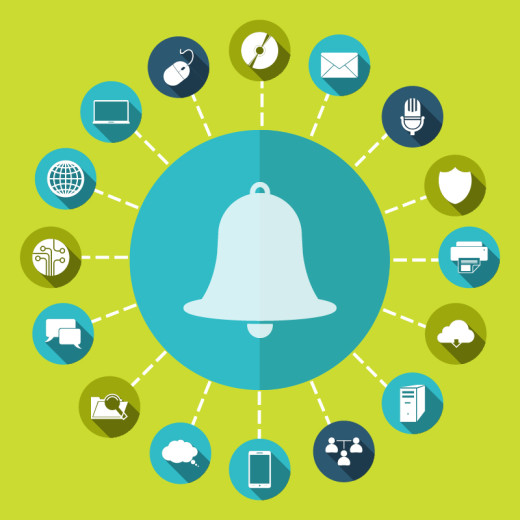
Starting an e-commerce business is tough. Running a profitable one is even tougher. Though there’s no shortage of tips and tricks on growing e-commerce sales, most of them will prove futile if you are not familiar with the right strategies.
People should not be unfamiliar with strategy. Those who understand it will survive, those who do not will perish. – Sun Tzu
Here are five such advance strategies that can improve your business and tips on how to maximize their effectiveness.
Use website push notifications
Push notifications is an excellent way to engage and communicate with your prospects and customers in real time. Mobile marketers use them to send sales alert, special offers, time-bound promotions and new items. Push notifications have a much higher open and click rates compared to emails. But when it comes to push notifications, most marketers only use the mobile app variety.
A recent study by SmartInsights found that desktop usage still accounts for 42 percent of total internet time. If you can add website push notifications in your marketing strategy, you can hyperactively target these people in real time basis (provided you have explicitly taken the permission from them). With website push notifications you can also target mobile users even if they don’t have an app.

Tip: When sending website push notifications, don’t forget to pay attention to the time zone your receivers are located in, especially if you’re targeting desktop users.
Invest in a good product recommendation engine
According to Forrester Research, 54 percent of retailers who use automated product recommendations increased their average order value year over year.
As e-commerce marketers, product recommendations aren’t new for us. We all know that recommending products are an extremely effective way to increase our average order size, but their relevance to the shopper is crucial to achieving success. Your product recommendations should be personalized for each shopper by his unique user behavior.
The more relevant your recommendations are to the shoppers, the better the chances of their buying more products from you. Recommendations also increase the chances of them returning to your site making it mandatory to invest in a good recommendation tool.
Tip: Invest in a recommendation engine that can go beyond its job of suggesting relevant recommendations. Choose a recommendation engine that can take into account the position of inventory too while suggesting recommendations. After all, you don’t want to recommend your shoppers a product that is out-of-stock, do you?
Additionally, checkout pages should be used to show items the buyer may need. It’s an effective way of recommending products as the buyer can already see the value by buying these products with the current one, and can quickly add them to the cart in one go without having to navigate away from the checkout page.
Real-time personalization
Nearly three-fourths of online consumers get frustrated with websites when content (e.g. offers, ads, promotions) appears that has nothing to do with their interests.
The days of “spray-and-pray” marketing are dead. Today, to win your prospect and improve customer allegiance, you need to provide your customers with a shopping experience customized to what they’re looking to buy.
The more relevant your offers are to your shoppers, the more likely they’ll buy. Especially considering 73 percent of consumers prefer to do business with brands that use personal information to make their shopping experiences more relevant.

If you’re not personalizing your marketing messages, you can’t expect good results. And if you implement personalization on only a few channels, your results won’t be as good as they should be.
According to a consumer survey conducted by MyBuys, 40 percent of consumers buy more from retailers who personalize the shopping experience across channels.
Today customers not only want a personalized experience on the web, but they also want the same experience as they traverse multiple touch points in their customer journey.

This is especially handy with abandoned carts. If a customer is shopping on their desktop, but gets distracted and abandons the checkout process, when they return (especially on your mobile site), simply show them a few relevant recommendations and the items lying in their cart to convince him to complete the transaction.
Over the next few years, we’re likely to see a lot more e-commerce companies personalizing their marketing messages across channels.
Tip: When personalizing your marketing messages it’s crucial not to over-personalize else it can backfire you. There’s a fine line between using customer information for personalizing the message and breaching privacy.
Automate your email marketing
Automation is essential to improving your email marketing game. Automating your entire email marketing strategy based on pre-set triggers helps you to send seamlessly hyper-relevant and timely messages, delighting subscribers.
You can be more proactive by setting up a series of autoresponders and make your marketing processes more effective. To give you an example, if you’re an online retailer, and you want to send an email to shoppers who abandon carts. The email will remind them about their cart and will encourage them to return to the site.
It wouldn’t be possible to send a timely email to the abandoners if you haven’t automated your email marketing, plus sending these emails manually will be a huge waste of time. Once you’ve set up your email marketing automation workflow, as soon as someone meet the trigger, the email will be delivered automatically on time, without you even lifting your finger.
According to stats, “Automated emails get 119 percent higher click rates than broadcast emails.”

Here are six email campaigns that every online retailer should automate:
- Welcome
- Browse recovery
- Abandon cart recovery
- Back-in-stock
- Birthday/anniversary
- Win-back
Tip: Automating email campaigns alone do not guarantee sales if your message is repetitive, or if your offer is irrelevant to your audience.
Invest in content
If you run an online store and haven’t invested in content, this might be one of the most valuable strategies you read in this post.
Content, if done well, can give your marketing superpowers. Content that is informative and engaging can help build trust with the customer over time. According to Econsultancy and EPiServer report, In e-commerce, 60 percent companies see content engagement increasing, and 30 percent of companies plan to invest more in creating original and unique content.
When creating your content generation strategy be sure to focus equally on self-generated as well as customer-generated content (product reviews). According to E-consultancy survey, “88 percent of consumers consult reviews when making a purchase, and 60 percent were more likely to purchase from a site that has customer reviews on.”
Tip: When creating content, make sure to focus on related keywords for your products to perform better in search results.
Takeaway
Running an e-commerce business is never a sure bet, but by implementing these strategies, you can stay assured that you’ haven’t left things on chance and chance alone. Also, all of these strategies work regardless of which one you use the most. So, you can pick few if you don’t have resources for all of them.
Read next: How Indian e-commerce will pan out
Get the TNW newsletter
Get the most important tech news in your inbox each week.